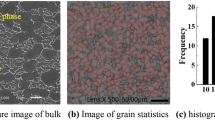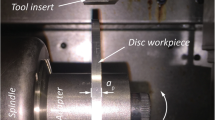Abstract
In this paper, the commercial FEM software package Abaqus is used to investigate the evolution of dislocation density and grain size in orthogonal cutting of Al6061-T6 alloy using microgrooved cutting tools. Microgrooves are designed and fabricated on the rake face of cemented carbide (WC/Co) cutting inserts. A coupled Eulerian-Lagrangian (CEL) finite-element model is developed based on Abaqus to solve the evolution of the dislocation density and grain size simultaneously. This validated CEL FEM model is then utilized to investigate the effects of microgrooved cutting tools on the evolution of dislocation density and grain size in orthogonal cutting of Al6061-T6 alloy. The effects of microgroove width and microgroove convex width are examined and assessed in terms of cutting force, chip morphology, dislocation density, and grain size. It is found that this CEL FEM model can capture the essential features of orthogonal cutting of Al6061-T6 alloy using microgrooved cutting tools. It is also concluded that microgrooved cutting tools can increase the cutting force in machining Al6061-T6 Alloys, which is contrary to the conclusion obtained for machining AISI 1045 in previous research. The reason for this might be due to the fact that Al6061-T6 alloy has relatively low Young’s modulus and consequently, it is much easier to fill the microgrooves within the tool-chip interface, making the microgrooves serve as microcutters instead of breaking the intimate contact between the chip and the rake face of the tool. It is also concluded that microgroove width and convex width can effectively change the dislocation density profiles and grain size profiles along the depth from the machined surface and the tool-chip interface, respectively, making it possible to alter the surface integrity of the machined surface based on needs.
Similar content being viewed by others
References
Ding H, Shin YC (2014) Dislocation density-based grain refinement modeling of orthogonal cutting of titanium. J Manuf Sci Eng 136(4):041003–041011. https://doi.org/10.1115/1.4027207
Ding H, Shen N, Shin YC (2011) Modeling of grain refinement in aluminum and copper subjected to cutting. Comput Mater Sci 50(10):3016–3025. https://doi.org/10.1016/j.commatsci.2011.05.020
Rotella G, Dillon OW, Umbrello D, Settineri L, Jawahir IS (2013) Finite element modeling of microstructural changes in turning of AA7075-T651 alloy. J Manuf Process 15(1):87–95. https://doi.org/10.1016/j.jmapro.2012.09.005
Wang Q, Liu Z, Wang B, Song Q, Wan Y (2016) Evolutions of grain size and micro-hardness during chip formation and machined surface generation for Ti-6Al-4V in high-speed machining. Int J Adv Manuf Technol 82(9-12):1725–1736. https://doi.org/10.1007/s00170-015-7508-1
Zhang X, Shivpuri R, Srivastava AK (2016) Chip fracture behavior in high speed machining of titanium alloys. J Manuf Sci Eng 138:194–204
CL P, Zhu G, Yang S, Yue EB, Subramanian SV (2016) Effect of microstructure softening events on the chip morphology of AISI 1045 steel during high speed machining. Int J Adv Manuf Technol 82:2149–2155
Zhang XP, Shivpuri R, Srivastava AK (2014) Role of phase transformation in chip segmentation during high speed machining of dual phase titanium alloys. J Mater Process Technol 214(12):3048–3066. https://doi.org/10.1016/j.jmatprotec.2014.07.007
Du J, Liu Z, Lv S (2014) Deformation-phase transformation coupling mechanism of white layer formation in high speed machining of FGH95 Ni-based superalloy. Appl Surf Sci 292:197–203. https://doi.org/10.1016/j.apsusc.2013.11.111
Pan Z, Liang S, Garmestani H, Shih D (2016) Prediction of machining-induced phase transformation and grain grouth of Ti-6Al-4V alloy. Int J Adv Manuf Technol 87(1-4):859–866. https://doi.org/10.1007/s00170-016-8497-4
Duan C, Kong W, Hao Q, Zhou F (2013) Modeling of white layer thickness in high speed machining of hardened steel based on phase transformation mechanism. Int J Adv Manuf Technol 69(1-4):59–70. https://doi.org/10.1007/s00170-013-5005-y
Ding L, Zhang X, Liu CR (2014) Dislocation density and grain size evolution in the machining of Al6061-T6 alloys. J Manuf Sci Eng 136: 041020-1-041020-9
Wu H, Duong N, Ma J, and Lei S (2017) CEL FEM Investigation of effects of microgrooved cutting tools in high speed machining of AISI 1045 steel. ASME 2017 International Manufacturing Science and Engineering Conference, MSEC2017–2932. June 4–8, 2017, Los Angeles, CA, USA
Ma J, Ge X, Qiu C, Lei S (2016) FEM assessment of performance of microhole textured cutting tool in dry machining of Ti-6Al-4V. Int J Adv Manuf Technol 84(9):2609–2621. https://doi.org/10.1007/s00170-015-7918-0
Ma J, Duong N, Lei S (2015) 3D numerical investigation of the performance of microgroove textured cutting tool in dry machining of Ti-6Al-4V. Int J Adv Manuf Technol 79(5–8):1313–1323. https://doi.org/10.1007/s00170-015-6937-1
Ma J, Duong N, Chang S, Lian Y, Deng J, Lei S (2015) Assessment of microgrooved cutting tool in dry machining of AISI 1045 steel. ASME J Manuf Sci Eng 137(3):031001 (9 pages)
Ma J, Duong N, Lei S (2015) Numerical investigation of the performance of microbump textured cutting tool in dry machining of AISI 1045 steel. J Manuf Process 19:194–204. https://doi.org/10.1016/j.jmapro.2014.10.001
Estrin Y, Toth LS, Moinari A, Brechet Y (1998) A dislocation-based model for all hardening stage in large strain deformation. Acta Mater 46(15):5509–5522. https://doi.org/10.1016/S1359-6454(98)00196-7
Koohbor B (2014) On the influence of rolling path change on static recrystallization behavior of commercial purity aluminum. Int J Mater Form 7(1):53–63. https://doi.org/10.1007/s12289-012-1113-8
Barlat F, Glazov MV, Brem JC, Lege DJ (2002) A simple model for dislocation behavior, strain and strain rate hardening evolution in deforming aluminum alloys. Int J Plast 18(7):919–939. https://doi.org/10.1016/S0749-6419(01)00015-8
ABAQUS (2014) ABAQUS user’s manual
CES EduPack (2011) Version 7.0
Miguelez MH, Munoz-Sanchez A, Cantero JL, Loya JA (2009) An efficient implementation of boundary conditions in an ALE model for orthogonal cutting. J Theor Appl Mech 47(3):599–616
Author information
Authors and Affiliations
Corresponding author
Rights and permissions
About this article
Cite this article
Wu, H., Ma, J. & Lei, S. FEM prediction of dislocation density and grain size evolution in high-speed machining of Al6061-T6 alloy using microgrooved cutting tools. Int J Adv Manuf Technol 95, 4211–4227 (2018). https://doi.org/10.1007/s00170-017-1476-6
Received:
Accepted:
Published:
Issue Date:
DOI: https://doi.org/10.1007/s00170-017-1476-6




